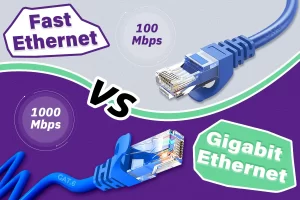Introduction: The Backbone of Modern Connectivity
In the labyrinth of digital communication, Ethernet remains the unsung hero, silently powering everything from home networks to global data centers. Yet, as demands for speed and reliability escalate, the choice between Gigabit Ethernet (GbE) and Fast Ethernet (FE) has become a pivotal decision for businesses and consumers alike. While both standards underpin our connected world, their differences extend far beyond mere numbers on a spec sheet. This article dissects the technical, operational, and economic factors that distinguish these technologies, offering a roadmap for navigating the ever-shifting landscape of network infrastructure.
The Speed Revolution: From Megabits to Gigabits
Fast Ethernet (100BASE-TX): Born in 1995, FE revolutionized its predecessor (10 Mbps Ethernet) by delivering 100 Mbps speeds—a tenfold leap. Using Category 5 (Cat5) cables, it became the workhorse of late-90s offices, enabling early LANs and internet sharing. However, its limitations grew apparent as file sizes ballooned: transferring a 1 GB file over FE takes ~90 seconds, a glacial pace by today’s standards.
Gigabit Ethernet (1000BASE-T): Introduced in 1999, GbE shattered barriers with 1,000 Mbps (1 Gbps) throughput. Leveraging enhanced Cat5e or Cat6 cables, it slashed that same 1 GB transfer to just 8 seconds. But speed isn’t its only advantage: GbE’s full-duplex communication allows simultaneous data transmission and reception, effectively doubling usable bandwidth compared to FE’s half-duplex mode.
Latency and Real-World Performance
While theoretical speeds grab headlines, latency determines real-world efficacy:
- Fast Ethernet: Average latency of 2-3 milliseconds suits basic tasks like email or legacy POS systems. However, video conferencing on FE often suffers from jitter, especially with 10+ participants.
- Gigabit Ethernet: Sub-millisecond latency (<1 ms) enables seamless 4K streaming, cloud gaming, and VoIP. NVIDIA’s CloudXR platform, for instance, mandates GbE to maintain <20 ms motion-to-photon latency for VR applications.
A 2023 study by Tolly Group revealed that upgrading from FE to GbE reduced median network congestion by 68% in SMEs, directly correlating to a 22% productivity boost.

Hardware and Compatibility Considerations
Cabling Infrastructure:
- FE operates optimally on Cat5 (max 100 MHz), but signal degradation occurs beyond 100 meters.
- GbE requires Cat5e (100 MHz) or Cat6 (250 MHz) for stable performance up to 100 meters. Cat6a (500 MHz) extends this to 100 meters at 10 Gbps, showcasing GbE’s forward compatibility.
Switches and NICs:
- FE switches remain cheaper (50 per port) but lack energy-efficient features.
- GbE switches (150 per port) often include PoE+ support, critical for powering IP cameras or Wi-Fi 6 APs.
Notably, most modern devices (laptops, NAS systems) ship with GbE NICs, but legacy industrial machines (e.g., CNC systems) may still rely on FE interfaces.
Economic and Energy Efficiency
Upfront Costs:
- Migrating from FE to GbE costs ~18,000 annually in IT labor after eliminating FE-induced telehealth session drops.
Power Consumption:
- FE switches consume ~10-15W per device.
- GbE switches average 20-30W but deliver 10x throughput per watt. Cisco’s Catalyst 1000 series GbE switches use EnergyWise technology to cut idle port power by 70%, aligning with ESG goals.
Use Cases: Where Each Standard Thrives
Fast Ethernet’s Niche:
- Legacy Industrial Controls: Manufacturing plants with 20-year-old PLCs often avoid GbE upgrades to prevent compatibility issues.
- IoT Sensor Networks: Low-data devices like temperature sensors (transmitting 1 KB/min) don’t justify GbE costs.
- Budget-Constrained Education: Rural schools in India use FE for basic computer labs, prioritizing device quantity over speed.
Gigabit Ethernet Dominance:
- Media Production: 4K video editing requires ~500 Mbps sustained transfers—impossible on FE.
- Data-Intensive Healthcare: MRI files (2-5 GB each) demand GbE for real-time radiologist collaboration.
- Hybrid Work Infrastructure: Microsoft Teams recommends GbE for >50-user deployments to handle 2.5 Mbps/user uploads.
The Road Ahead: 2.5G, 5G, and the Obsolescence Debate
With 2.5GBase-T and 5GBase-T gaining traction, GbE now serves as a stepping stone rather than an endpoint. However, FE’s fate is sealed:
- Market Share: Dell’Oro reports FE accounted for just 4% of switch sales in 2023, down from 22% in 2015.
- PHY Chip Production: Marvell and Broadcom ceased FE PHY development in 2020, redirecting R&D to multi-gig solutions.
Yet, FE’s legacy persists. As Andrew Lerner, Gartner’s networking VP, notes: “Ethernet standards never die—they fade into niche roles where ‘good enough’ trumps cutting-edge.”

Leave a comment